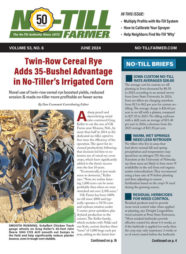By Anna Cates, State soil health specialist
One benefit of increasing soil organic matter is to store more water in your soil. Why does this happen? Because soil organic matter creates pores in a range of sizes. Exactly how much more water is stored due to soil organic matter will depend on soil texture, though.
Soil organic matter is a busy mix of materials — fragments of last year’s stalks and roots, earthworm casts, and living microbes and invertebrates, to name just a few. These materials are broken down by physical and biological processes. For example, freezing and thawing causes plant residue to lose its structure. Tiny dissolved molecules flow deep into the soil with rainwater. Hungry invertebrates, fungi, and bacteria consume complex living and dead organic material and excrete nutrients they don’t need in a smaller, simpler form. These small organic molecules can stick to clay surfaces. Clay surfaces covered with organic material grow like snowballs, and soil aggregates are formed.
How soil aggregates affect soil water
Soil aggregates are critical for holding water in the soil for two reasons. First, a well-aggregated soil has large pores between aggregates to let water enter the soil profile. Second, small pores within aggregates hold water tightly enough to keep it around, but loosely enough for plant roots to take it up. It’s critical that soil both let water flow through and hold water for later. If your soil doesn’t let water infiltrate, you'll have ponding, runoff and soil loss, and lower plant water supply. If your soil doesn’t hold water, plants suffer from drought.
So, soil organic matter is critical for forming aggregates, and aggregates are critical for holding water. Because of that link, there is definitely a positive relationship between organic matter and water-holding capacity. How much water-holding capacity increases depends on your soil type.
Plant-available water capacity
We’re mostly interested in the soil water as it relates to plant-available water. Plant-available water capacity is water held by soil against the pull of gravity (i.e., it doesn’t wash through) but not too tightly for plants to draw it in. You see a bigger bump in plant-available water capacity when you increase organic matter in coarse-textured soils than finer loams or clays. This is because coarse soils naturally have larger pores between particles and really need the organic matter to develop small pores. Fine-textured soils already have small pores and aggregate more easily, so there are diminishing returns on increased organic matter. More soil organic matter means more soil pores and lower bulk density. Some of those pores are large, which is great for infiltration, but won’t increase plant-available water capacity.
You can calculate how much more water holding capacity you might get from increasing organic matter, but the number varies with soil type. For example, a recent compilation of studies found that available water capacity in medium-textured soil increased by 1.03% with every 1% OM increase (Minasny & McBratney 2017). If you’re starting with available water capacity of 22% (moderate for a silt loam according to NRCS), adding 1% OM would bring you up to 23.03% available water capacity (Table 1).
| Soil texture* | AWC increase per 1% OM increase (%)** |
AWC increase per 1% OM increase (gal.) |
Initial AWC (gal.) |
AWC after 1% OM increase (gal.) |
| Loamy sand (0.5-3%) | 1.13 | 3,666 | 32,583 | 36,249 |
| Silt loam (3+% OM) | 1.04 | 3,383 | 71,682 | 75,075 |
| Clay loam (3+% OM) | 0.82 | 2,665 | 55,391 | 58,056 |
*Average initial AWC by soil texture from NRCS data: https://www.nrcs.usda.gov/wps/portal/nrcs/detail/soils/survey/office/ssr10/tr/?cid=nrcs144p2_074839
**Average increase in AWC per 1% OM for coarse, medium and fine soils based on Minasny and McBratney, 2017, converted from increase per 1% OC using van Bemmelen Factor (OM%=C% x 1.724)
3,500 gallons is just an estimate. What’s important is that increasing organic matter fundamentally changes the soil structure. We can’t push soil from a loamy sand to a clay loam. But management focused on protecting soil structure and building soil organic matter, like reduced tillage and continuous living cover, can build organic matter and improve soil function.






Post a comment
Report Abusive Comment